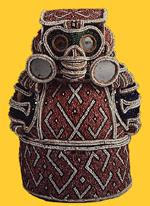
Mountain City, Georgia (UCTP Taino News) - The pastel and oil fine art portraits by Mildred "Mucara" Torres-Speeg (Taino), award winning, internationally recognized artist, will be on exhibit Dec.28, 2004 through Feb.27, 2005 in the Heritage Room Gallery of the Georgia Heritage Center for the Arts, Hwy. 441 N., Tallulah Falls, Georgia. The exhibit, "Power of Spirit" is free and open to the public. A "Meet the Artist" reception will be held on Jan. 1st from 1:00 p.m. to 4:00 p.m. in the Georgia Heritage Center for the Arts.
A respected Taino community elder, Torres-Speeg will display a variety of paintings, including "Claudia – Taino Woman", which was featured at the United Nations ART EXHIBITION "IN CELEBRATION OF INDIGENOUS PEOPLES" sponsored by the UN Permanent Forum on Indigenous Issues from May through August, 2004. If you missed the UN exhibit, you can now see "Claudia," in Tallulah Falls, GA., along aith "Winterhawk"; "Spirit of the Hurricane"; "The Shaman"; "Taino Warrior" and other paintings depicting the life and culture of the Indigenous Peoples of North, South and Central America.
"Mucara" Torres-Speeg is the United Confederation of the Taino People Liaison Officer for the State of Georgia, an active member of the NGAG and past president of the Albany Georgia Artists Guild. She has exhibited at the Georgia Council for the Arts, Albany Museum of Art, State Capital Gallery, Atlanta, Andrew College, Jimmy Carter Library, Georgia Southwestern State College, Atlanta Spirit of America-Native American and Wildlife Art Festival, private collections and numerous others. Her work can be viewed at http://www.worldsbestart.com/ and http://www.nighteaglestudio.com/.
For directions or information about the exhibition, please call 706-754-5989. The Art Gallery hours are Mon – Sat 10 – 5 and Sun 1-5.
A respected Taino community elder, Torres-Speeg will display a variety of paintings, including "Claudia – Taino Woman", which was featured at the United Nations ART EXHIBITION "IN CELEBRATION OF INDIGENOUS PEOPLES" sponsored by the UN Permanent Forum on Indigenous Issues from May through August, 2004. If you missed the UN exhibit, you can now see "Claudia," in Tallulah Falls, GA., along aith "Winterhawk"; "Spirit of the Hurricane"; "The Shaman"; "Taino Warrior" and other paintings depicting the life and culture of the Indigenous Peoples of North, South and Central America.
"Mucara" Torres-Speeg is the United Confederation of the Taino People Liaison Officer for the State of Georgia, an active member of the NGAG and past president of the Albany Georgia Artists Guild. She has exhibited at the Georgia Council for the Arts, Albany Museum of Art, State Capital Gallery, Atlanta, Andrew College, Jimmy Carter Library, Georgia Southwestern State College, Atlanta Spirit of America-Native American and Wildlife Art Festival, private collections and numerous others. Her work can be viewed at http://www.worldsbestart.com/ and http://www.nighteaglestudio.com/.
For directions or information about the exhibition, please call 706-754-5989. The Art Gallery hours are Mon – Sat 10 – 5 and Sun 1-5.










